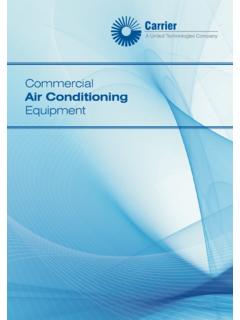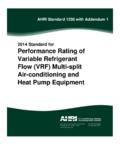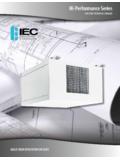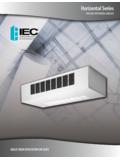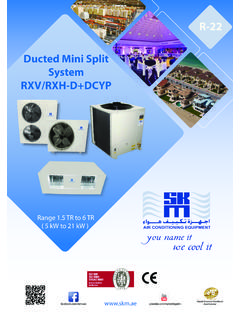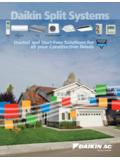Transcription of FAN COIL e2 ENGINEERING - Krueger-HVAC
1 FAN COIL ENGINEERINGFAN COIL | Excellence in Air Distributione2-2 KRUEGER 2012 FAN COIL ENGINEERINGFAN COIL ENGINEERINGe2 Table of ContentsFAN COIL ENGINEERINGI ntroduction ..e2-3 Properties of coils and Coil Design ..e2-3 Vertical Stack Risers ..e2-4 Hydronic Specialties ..e2-5 Product Overview ..e2-6 Features Standard Capacity - Horizon Series ..e2-7 horizontal High Capacity - Horizon-X Series ..e2-8 Vertical High Capacity - Vega-X Series ..e2-8 Vertical Standard Capacity - Vega Series ..e2-9 Vertical Stack - Vesper Series ..e2-10 Heat Transfer Principle.
2 E2-11 Room Load Calculations ..e2-12 Psychrometrics ..e2-13 Providing You With Air Distribution Solutionse2-3 KRUEGER 2012 FAN COIL ENGINEERINGFAN COIL ENGINEERINGe2 IntroductionPROPERTIES OF coils AND COIL DESIGNFan coil units can be used to introduce outdoor air into a space, circulate and filter air within a space, and provide heating and/or cooling within a space. The basic components of a fan coil unit are a heating/cooling coil, fan section, and a filter. Units may stand alone within a single space or be ducted to serve multiple spaces, and can be controlled by a manual switch, thermostat, or building management coil units are typically selected and sized to heat and cool a small zone with specific load requirements.
3 A zone may consist of a single undivided space, a partitioned room, or multiple rooms with similar smaller loads that together add up to the total load the fan coil unit is designed to handle. Such fan coil systems can be controlled by a single, centrally located thermostat. If the system incorporates a ducted return air system, a return air sensor mounted in the common duct could also provide accurate comfort conditioning temperature control. Vertical fan coil units, either in stack configuration for a high rise or floor mounted stand-alone units in individual spaces are usually utilized only for single room applications and are often controlled by a thermostat mounted in the space or on the unit itself.
4 Depending upon the control system of the building, the control of most fan coil units can be incorporated into the Building Control System or Building Energy Management System if dictated by the design. Typically, the water in a hydronic piping system that serves the fan coil units and other HVAC equipment is supplied to the central plant or building by the local utility; from there, heat is transferred to or from the water by means of a boiler used to supply hot water or a chiller used to provide cold water. Chemical treatment of water is often involved, including addition of propylene or ethylene glycol to prevent freezing.
5 It is important to note that these additives alter the heat transfer properties of the fluid; this difference should be accounted for when selecting and sizing the system. The water is then piped through hot water or chilled water primary and secondary supply lines. Supply water is piped to the bottom of the coil to ensure that any air bubbles forming in the supply water will be transmitted to the upper level where they can be discharged from the system through the optional air vent on the return pipe immediately outside the coil. Two-pipe and four-pipe configurations are piping options used in fan coil unit systems.
6 Just as it sounds, a two-pipe system is literally served by two pipes a supply and return. Either chilled or hot water through the pipes can be supplied and returned, not both. This requires system changeover from heating to cooling or cooling to heating. Although they have the advantage of lower initial costs associated with piping and installation, two-pipe systems offer less flexibility with heating and cooling demand as it will not allow heating in one unit and cooling in another. This can sometimes be problematic, such as when seasonal or occupancy loads change.
7 Four-pipe systems consist of chilled water supply and return and hot water supply and return. An actuated three-way valve with chilled and hot water supply entering can be controlled by a room thermostat or return air sensor and signal either the hot or chilled water supply side to open or close. In contrast to two-Air StreamT = 80 FT = 60 FTs = 45 FT = 55 FTs = 45 FT = 45 F FIGURE 1: COIL DESIGNInOutAirReturnBend End FIGURE 2: PARALLEL FLOWInOutAirReturnBend End FIGURE 3: CROSS FLOWFan Coil Introductionpipe systems, four-pipe systems often have higher piping and installation costs but are capable of maintaining higher levels of occupant comfort in all | Excellence in Air Distributione2-4 KRUEGER 2012 FAN COIL ENGINEERINGFAN COIL ENGINEERINGe2 IntroductionRRRBOILERCHILLERSSSFCUFCUFCU FCUFCUFCUFCUFCUFCUFCUFCUFCU FIGURE 6.
8 horizontal 2-PIPE, REVERSE RETURNRRRRBOILERCHILLERSSSSFCUFCUFCU FIGURE 7: VERTICAL 2-PIPE, REVERSE RETURNRRRBOILERCHILLERSSSFCUFCUFCUFCUFCU FCUFCUFCUFCUFCUFCUFCU FIGURE 4: horizontal 2-PIPE, STD RETURNRRRBOILERCHILLERSSSFCUFCUFCU FIGURE 5: VERTICAL 2-PIPE, STD RETURNFan Coil IntroductionTwo different configurations are available for return piping, standard return and reverse return. In the standard configuration, (Figures 4, 5, and 8), water flows from the first fan coil in the loop through the last, and returns from the last unit back through the first. In a reverse return system, (Figures 6, 7, and 9)
9 , both the supply and return flow run from the first unit in the system through the last and returns to the chiller through a separate You With Air Distribution Solutionse2-5 KRUEGER 2012 FAN COIL ENGINEERINGFAN COIL ENGINEERINGe2 Introduction VERTICAL STACK RISERSIn high rise buildings such as apartments, condominiums, or hotels where the lay-out of each floor is very similar, utilizing vertical stack fan coil units in the design can decrease installation costs and simplify the scope of equipment to be supplied. Each floor can be typical of the ones above and below, and therefore use common supply, return, and condensate pipes.
10 This common piping is known as a riser, and vertical stack fan coil units are pre-piped with riser piping. In riser systems, a two-pipe system would consist of three pipes, including the condensate return pipe, and a four-pipe system would consist of five pipes including the condensate return. If the piping provided is not long enough to connect from floor to floor, riser extensions can be installed to connect the unit to another unit on an adjacent floor. Riser extensions can also be used as the reducer, as the pipe diameter must decrease or increase to maintain head pressure and flow requirements.



